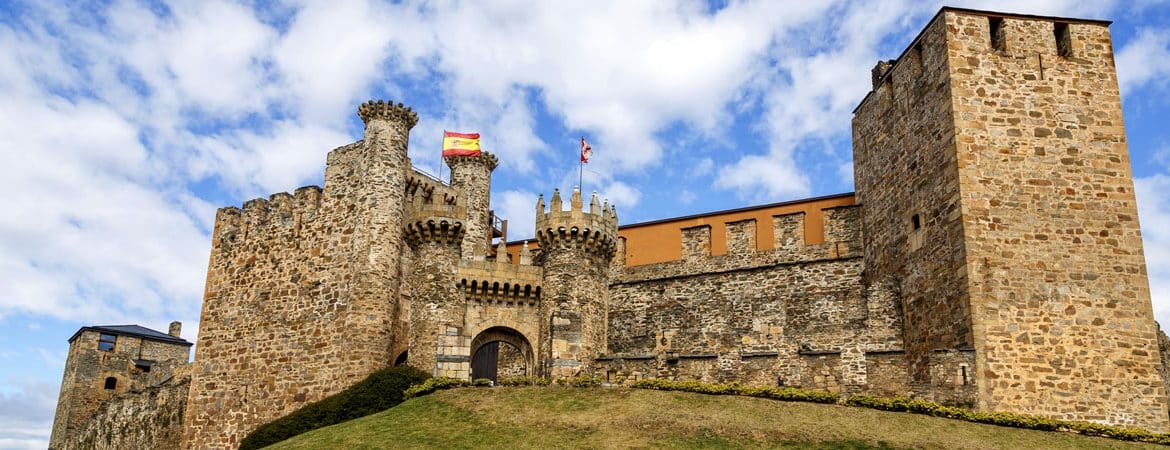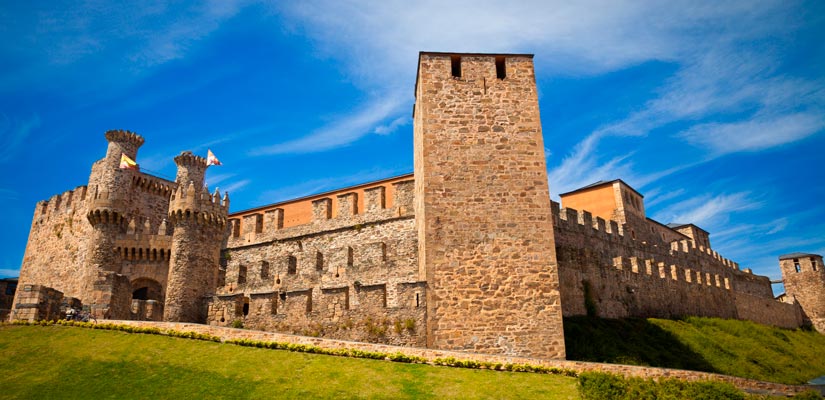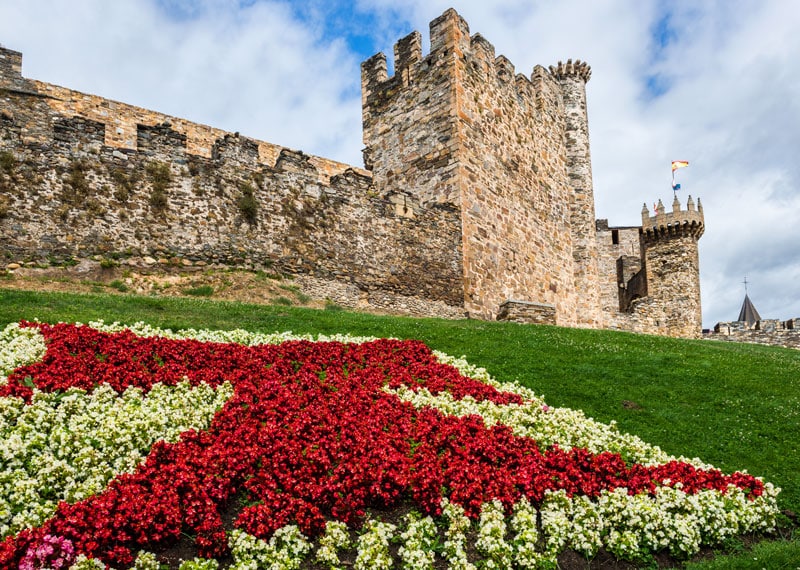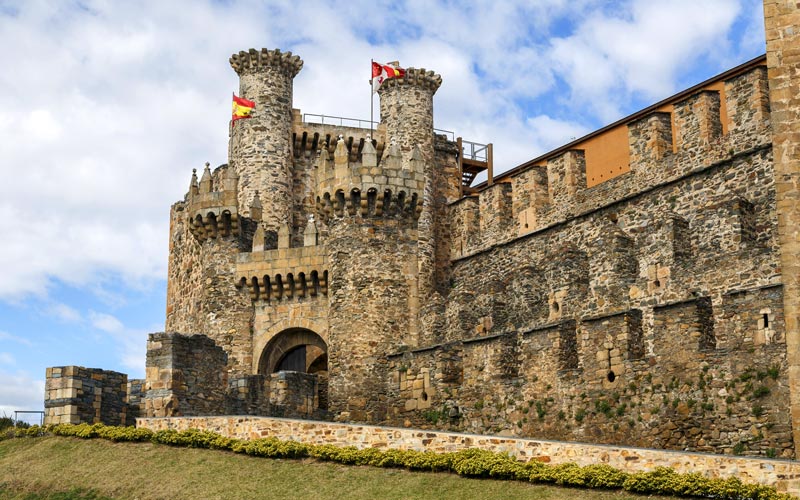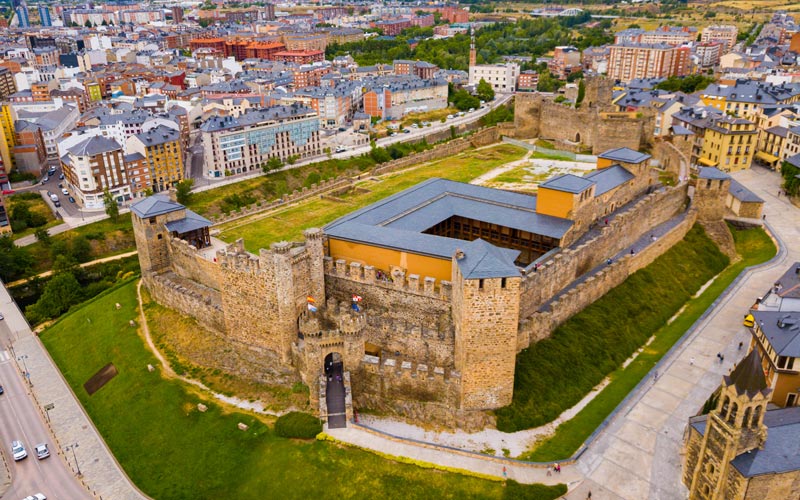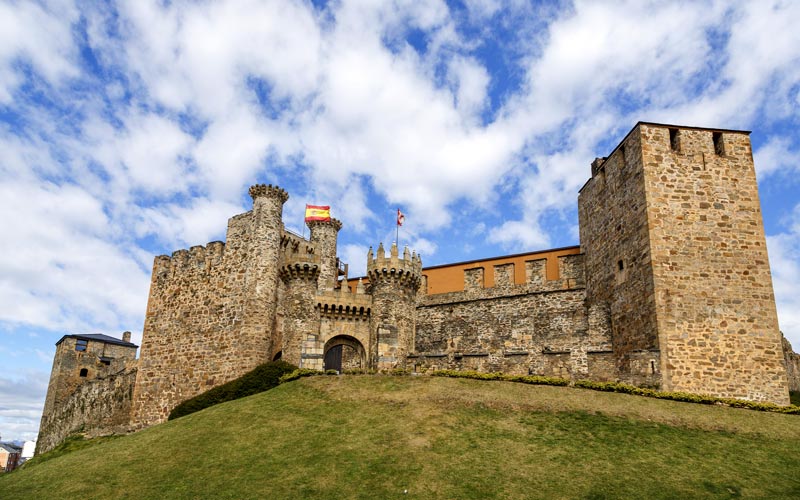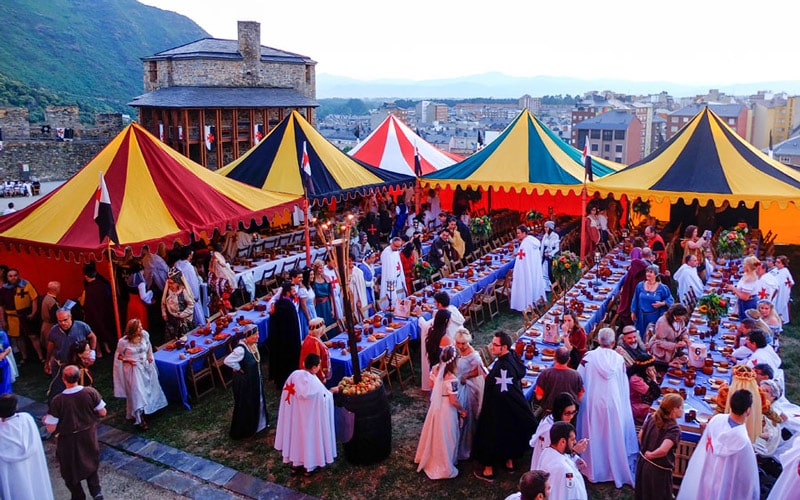The Castle of Ponferrada is located in the city of the same name, in the region of El Bierzo, León. It is situated at the top of a hill where the rivers Sil and Boeza meet. It forms an enclosure of more than 8,000 square meters in which there are strong defenses that form towers, barbicans, rooms and a courtyard. During the Middle Ages it was established as one of the largest fortresses in northwestern Spain.
In 1211 King Alfonso IX donated the town of Ponferrada to the Order of the Temple. In 1226 the Templars had already taken charge of fortifying Ponferrada. Thus, the castle is attributed to the Templars, who lived in the area until 1312. The castle constitutes a very complex military work that has been extended and reformed over time, as its construction corresponds to different periods.
It is in a privileged location, in the very heart of Ponferrada, among mountains, rivers and experiences of pilgrims who pass by the castle every day. The walls of the castle awaken past times when the Templar monks inhabited it, being rebuilt later by many nobles. Ponferrada’s castle has a long history that is an example of the many attached buildings both inside and outside the fortification. This visit to the walled enclosure hides legends in which each tower or section of the castle has its own name or a shield between its stones.
In the Castle of Ponferrada you can also visit the bibliographic exhibition Templum Libri, with more than a hundred works. Here you can see codices and religious manuscripts, the “Libro de Kells” dating from the 9th century (the oldest in the exhibition), scientific works and illustrated literature by renowned artists such as Dalí, Picasso and Chillida.
History of the Castle of Ponferrada, home of the Templars
The arrival of the Templars at the castle took place in 1178, with the aim of serving to the interests of the kings Alfonso IX and Ferdinand II. Furthermore, in this way, the Order of the Temple would protect the Way to Santiago and its pilgrims from a Muslim invasion. They also had to prevent confrontations between the nobles of León and Galicia who wanted to take over the territory.
During the century and a half that the warrior monks lived in Ponferrada they carried out different works. Outside the castle they are in charge of reinforcing the wall. Meanwhile, in the interior they built outbuildings such as houses, a Templar convent, cellars, orchards…
With the arrival of the 13th century the lordship of Ponferrada became the property of the Templars thanks to the King of Leon, Alfonso IX. Thus, they also acquired the domain of the castle of Cornatel. Legend has it that there was a secret passage that connected the two fortresses. By the year 1300 the Order of the Temple already accumulated 870 castles, a long list of knights and great wealth. So much so, that the European leaders begin to be suspicious of such power.
In 1312, Pope Clement V orders the dissolution of the Order
In 1307 Pope Clement V orders that all Templars are to be arrested and their property confiscated. This scenario led the Master of the Order, Rodrigo Yáñez, to appear in Valladolid. There he met with Queen María de Molina, with whom he agreed to hand over the castles of the Order in a period of time established between them. However, the master will have another meeting with the Infante Don Felipe in which he gives him different goods and among them, the domain of Ponferrada. At this point, the uncle of King Ferdinand IV intervenes, that is to say, the infante Don Juan, who claims the property.
To end the conflict, the queen meets with her son Philip in Leon. It is then that he alerts her about the accusation that the Pope has made against the Templars. Thus, the pontiff orders the queen and her son to arrest all the Templar friars and to confiscate their goods. To settle the complicated situation, Don Felipe offers King Ferdinand IV the domain of Ponferrada, as well as the properties that the master gave away: the castles of San Pedro de Latarce, Haro and Alcañices.
After the agreement, in 1308 the Crown recovers the possession of the castle and the town of Ponferrada. In 1312 the king died in suspicious circumstances, and his son Alfonso XI succeeded him. The lordship of Ponferrada is given to Pedro Fernández de Castro, who acquires it in 1340. In this period the Old Castle and the Old Tower of Homage are built, where the coat of arms of his family is located. When he died, after years of family disputes, the property returned to the Crown, where it ended up in the hands of the Duke of Arjona. In his domain he orders the erection of a new tower that will be built in the Old Castle.
However, of all the lords who lived in the Castle of Ponferrada the most notorious is the first Count of Lemos, called Pedro Álvarez Osorio. He obtained the domain after marrying the heiress of the Duke of Arjona, Beatriz de Castro. During his dominion, great extensions were carried out. For example, five towers are built (Moclín, Cabrera, Caracoles, Malpica and Malvecino), the main entrance and its defensive system are carried out, the New Palace is built…
Disputes over control of the castle and city
When the Count of Lemos dies without recognized descendants, disputes over his inheritance begin, until the Catholic Monarchs take over. In later centuries the fortress will be governed by different governors chosen by the Crown.
The first will be Juan de Torres, who will order the construction of the Tower of the Catholic Monarchs built between 1492 and 1502. The coats of arms of its benefactors are marked on it: Juan de Torres and the Catholic Monarchs. Moreover, it is thought that during these years reinforcement works were carried out in the Mora Cave, which was built during the mandate of the Count of Lemos. It was an access to the river Sil to ensure the supply of water to the castle of Ponferraba if they had to resist a siege.
Isabella the Catholic died in 1504 and two years later, Fernando de Torres, endorsed by Ferdinand the Catholic, became the new warden of the city. During his leadership, in 1507, the current Count of Lemos raided the castle of Ponferrada, although he lost it a few months later after seeing his allies abandon him.
The Crown once again took charge of the castle until 1558, when the lordship of Ponferrada was left in the hands of the Count of Lemos’ descendants. Thus, the Marquises of Villafranca assumed the government of these goods until the arrival of the 19th century. However, the lack of investment in the conservation of the castle causes its deterioration.
In 1924, on the verge of falling into ruin, it was finally protected as a National Monument and later catalogued as an Asset of Cultural Interest.
The Castle of Ponferrada and the Way to Santiago
With the revaluation of the Way to Santiago in the 20th century, infrastructures are improved, sections are restored and the Way is correctly marked. The castle of Ponferrada is part of this route to the cathedral of Santiago. As it has been done for centuries, visitors who arrive at the castle contemplate the entrance arch with the Tau inscribed. This has a double meaning, it is both the emblem of the County of Lemos and a symbol of protection for the pilgrims who make the Way to Santiago.
Nowadays, the Templars’ castle, as Ponferrada’s castle is known, has rescued the prominence it had in other times, becoming the most representative currency of the Leonese town.
The Templar night of Ponferrada
With the first full moon of the summer, the Templar Night is celebrated in Ponferrada, specifically between the end of June and the beginning of July. This medieval festival takes the city back to the 12th century. The castle of Ponferrada and the streets of the town are set in medieval times, with Templar banners and motifs. The locals wear their best medieval clothes and many activities take place, such as street shows, jousts, theatres, markets…
Mysticism envelops Ponferrada during these days, representing the return of the Master of the Order of the Temple to the city, handing over two sacred symbols: the Holy Grail and the Ark of the Covenant. To complete the act, music and fireworks will end with the bell.

